Within the dynamic world of undertaking administration, Undertaking Administration Workplaces (PMOs) play an important position in orchestrating technique execution throughout organizational tasks. PMOs want the suitable instruments that not solely streamline but in addition amplify their undertaking administration capabilities. For a lot of organizations, a single undertaking administration device might not meet all the mandatory use instances, which is why a couple of undertaking administration resolution could also be utilized. One common resolution is Asana, a piece administration platform designed for simplified undertaking administration. On the similar time, undertaking portfolio administration has developed considerably, and PMO’s and Portfolio Managers want the suitable device to trace and handle their undertaking portfolio. Is Asana a portfolio administration resolution? On this new sequence on undertaking administration software program, we’ll have a look at undertaking administration performance and current portfolio administration capabilities. On this submit, we’ll firstly discover Asana’s high undertaking administration options after which reply the query about portfolio administration. In future posts, we’ll have a look at Monday.com, Wrike, and Smartsheet.
What We Like About Asana for Undertaking Administration
Asana for undertaking administration has lots of nice capabilities that many undertaking groups will make the most of. We discover Asana to be a simple to make use of resolution for a lot of kinds of Undertaking Managers. We just like the a number of schedule views, integration capabilities, and love the aim monitoring options.
Centralized Undertaking Monitoring
Asana affords a simple approach to centralize undertaking administration, which is important for PMOs. You possibly can create tasks that function a single supply of reality for all project-related duties, deadlines, and communications. This centralization eliminates the silos that always plague massive organizations, guaranteeing that each crew member, from the Undertaking Supervisor to the Stakeholders, is aligned and knowledgeable. Initiatives could be personalized with sections, customized fields, and tags to categorize duties by precedence, standing, or crew, enhancing visibility and management over undertaking progress.
Process Administration and Dependency Administration
Asana’s job administration capabilities are good for creating fundamental undertaking plans. Duties could be damaged down into subtasks, providing a granular stage of element that’s important for extra detailed tasks. Asana lets you set job dependencies, guaranteeing that duties are accomplished in the suitable sequence, which is crucial for elementary undertaking scheduling and useful resource administration. This prevents bottlenecks and ensures that undertaking timelines are met with better reliability. Asana gives totally different views of the undertaking particulars corresponding to an inventory view, calendar view, and Gantt view.
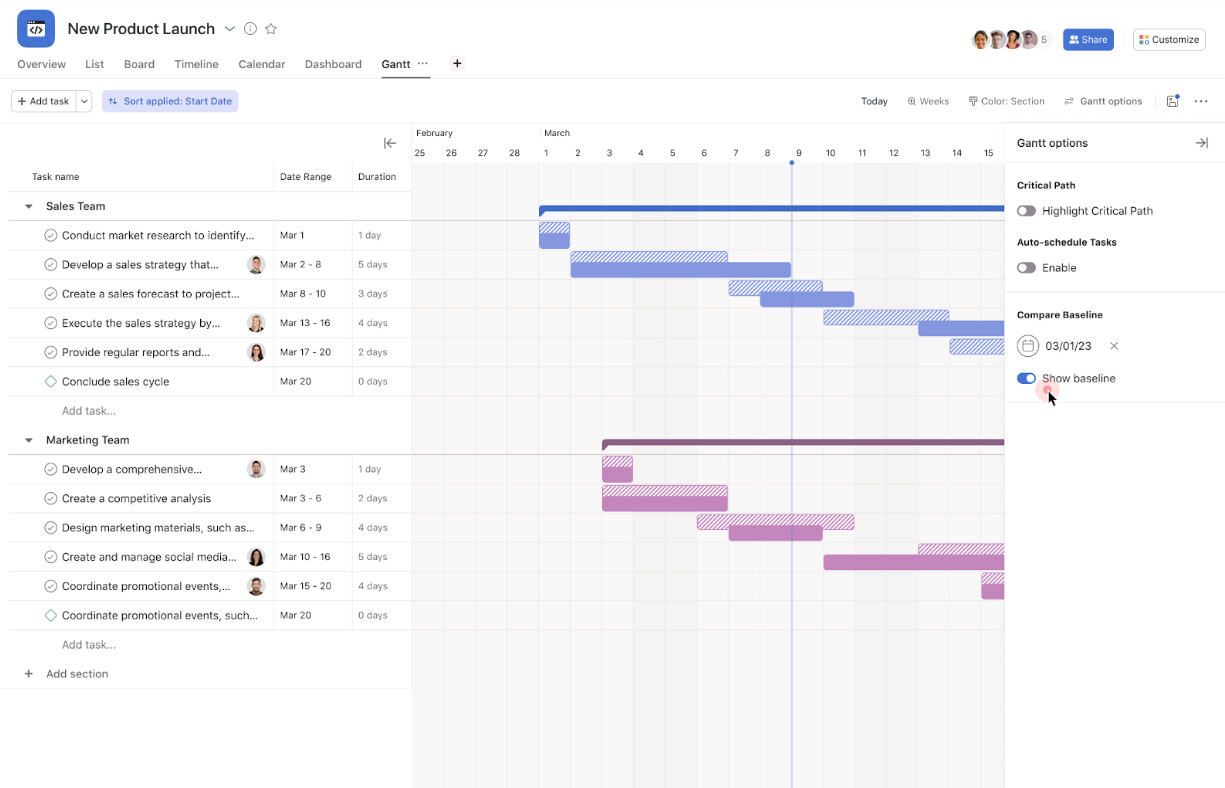
Automation and Workflow Templates
For PMOs, effectivity is not only about managing duties but in addition about automating repetitive processes. Asana’s automation guidelines can set off actions primarily based on particular circumstances, like robotically updating a job’s standing or notifying crew members when a job is accomplished. Furthermore, the platform’s template characteristic permits PMOs to standardize undertaking workflows. You possibly can create templates for undertaking charters, standing stories, or any recurring undertaking kind, saving time and guaranteeing consistency throughout tasks. It is a nice characteristic of Asana for undertaking administration.
Collaboration and Communication
Efficient communication is the spine of undertaking success. Asana excels right here by integrating all crew interactions throughout the platform. Conversations about duties, updates, and recordsdata are stored in context, lowering the necessity for countless e mail threads or conferences. Group members can depart feedback on duties and use @mentions to loop in related crew members. Group members can even add recordsdata on to duties, guaranteeing easy accessibility to project-related paperwork. PMOs can leverage these options to make sure that discussions and communication are instantly linked to duties or tasks, offering readability and context. The platform additionally helps sharing undertaking views, permitting stakeholders to see precisely what’s taking place with out deep diving into undertaking administration nuances.
Visibility and Reporting
Visibility into undertaking well being, useful resource allocation, and progress is essential for PMOs. Asana gives complete reporting options the place PMOs can generate customized stories or dashboards to evaluate undertaking efficiency and crew workload. This visibility helps in making data-driven choices and reallocating sources. Pre-built widgets assist groups visualize information in codecs that resonate with them. Undertaking Managers can share stay dashboards with stakeholders to take care of transparency and belief. Actual-time updates imply that these stories are at all times present, providing a stay pulse on undertaking standing which is invaluable throughout government evaluations or for strategic planning.
Integration Capabilities
In an ecosystem the place groups use varied instruments, Asana’s integration capabilities stand out. It integrates seamlessly with instruments like Google Workspace, Slack, Microsoft Groups, and plenty of others by way of Asana’s API or third-party integrations like Zapier or Make. This implies PMOs can join Asana to their current tech stack, syncing information, automating workflows throughout functions, and guaranteeing that Asana turns into a pivotal hub within the organizational workflow. This connectivity reduces guide information entry, enhances information integrity, and fosters a extra linked work setting.
Purpose Setting and Alignment
One of many evolving roles of the PMO is guaranteeing that tasks align with broader organizational targets. Asana has an important goal-setting characteristic that permits cascading targets the place high-level strategic targets could be damaged down into actionable team-level duties. Purpose accountability is dealt with by assigning aim homeowners to particular targets, fostering accountability and transparency throughout groups. With these options, PMOs can outline, observe, and talk targets instantly throughout the undertaking administration context. Groups can see how their duties contribute to bigger targets, which not solely boosts motivation but in addition ensures that each undertaking is steering in direction of the corporate’s strategic path. This characteristic is especially helpful throughout strategic planning classes or when reevaluating undertaking priorities.
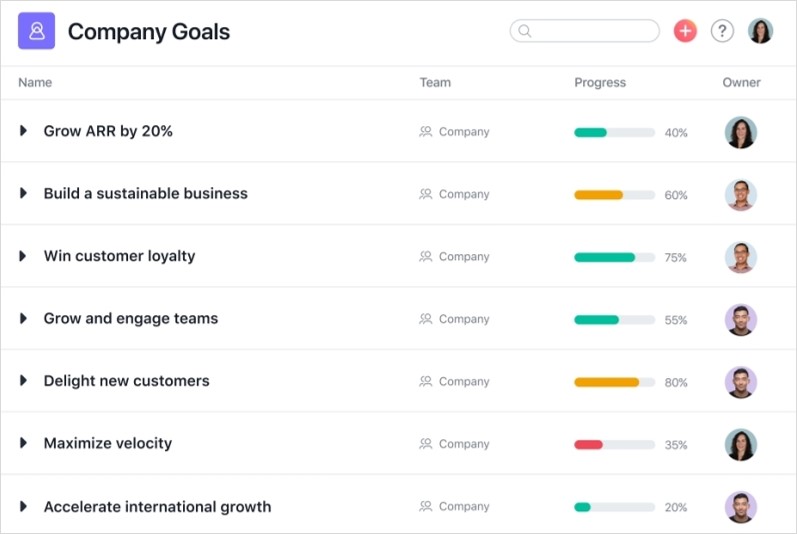
What We Don’t Like About Asana for Undertaking Administration
Asana is nice for the frequent Undertaking Supervisor, however for senior Undertaking Managers searching for superior undertaking scheduling capabilities present in instruments like Microsoft Undertaking or Primavera, Asana will disappoint. We even discovered that there’s no area in an Asana undertaking highlighting the beginning and end date. This makes it very tough to combine different options that want the beginning and end date.
Limitations of Asana for Portfolio Administration
Let’s flip our consideration again to the query of whether or not Asana is a portfolio administration resolution. Whereas Asana shines in job and crew administration, its capabilities in dealing with portfolio administration, notably for PMO Administrators and Portfolio Managers, Asana for portfolio administration comes with a number of limitations that may hinder its effectiveness for complete PPM and is probably not appropriate for portfolio administration for a lot of organizations.
Asana for portfolio administration lacks a number of options that seasoned PMOs may anticipate for efficient portfolio administration. Asana for portfolio administration lacks strong work consumption, prioritization scoring fashions, enterprise useful resource capability planning, portfolio-level threat administration, monetary monitoring, interdependency administration, and even fundamental PMO instruments corresponding to classes discovered and determination logs. Most of those key options for portfolio administration are both not obtainable in any respect, require important workarounds to realize, or solely help very fundamental portfolio administration. This will result in inefficiencies and improve the workload on PMOs.
Work Consumption with Asana for Portfolio Administration
Work consumption is likely one of the most important capabilities of undertaking portfolio administration. Whereas Asana for portfolio administration affords a configurable request type, this is just one a part of the consumption course of. PMO’s and governance groups want a broad set of data to pick out the suitable tasks for inclusion within the portfolio.
No Prioritization with Asana for Portfolio Administration
Asana doesn’t provide a strong scoring mannequin functionality to generate a price rating and threat rating for every undertaking within the portfolio. It is a important limitation with Asana for portfolio administration. PMO’s and management can not do a good analysis of every undertaking and perceive the extent of threat throughout the portfolio, nor can tasks be robotically ranked throughout the portfolio.
Useful resource Capability Planning
Though Asana has made nice strides in providing project-level useful resource planning, it doesn’t present in-depth useful resource forecasting or utilization metrics on the enterprise stage. Understanding useful resource utilization on the crew and division stage just isn’t obtainable out-of-the-box and is simply partially obtainable with personalized dashboards. PMOs might discover it difficult to handle useful resource capability successfully with Asana for portfolio administration.
Monetary Monitoring
Asana for portfolio administration doesn’t provide native options for budgeting, price monitoring, or ROI evaluation. PMOs usually must depend on exterior integrations or guide processes to handle monetary information, which may result in inefficiencies and errors.
Danger Administration
There is no such thing as a normal out-of-the-box threat log in Asana for undertaking administration. Danger registers have to be customized constructed for every undertaking, however even when templates are utilized, the interface between tasks and the chance logs are compromised. Asana additionally lacks any type of portfolio-level roll-up for visibility of essential dangers throughout the portfolio and doesn’t provide true portfolio threat administration.
Interdependency Administration
Asana’s dependency monitoring is task-focused, which can not suffice for PMOs managing intricate undertaking interdependencies. Asana for portfolio administration lacks the visibility to rapidly perceive the kinds of relationships between tasks and the extent of severity.
Lack of Devoted Portfolio Reporting
For portfolio administration, superior, customizable reporting is essential. Though Asana for portfolio administration does present some PMO stories, these are sometimes criticized for being too fundamental or not sufficiently adaptable for the nuanced wants of portfolio administration. PMOs may discover it difficult to get a holistic view of portfolio well being, threat evaluation, or useful resource allocation throughout a spectrum of tasks with out integrating further reporting instruments or manually compiling information, which could be time-consuming and error-prone.
In abstract, whereas Asana serves nicely for particular person undertaking administration and crew coordination, Asana for portfolio administration lacks quite a lot of capabilities. PMO Administrators searching for a extra strong and scalable portfolio administration resolution will miss these capabilities in Asana for portfolio administration. These limitations might immediate PMOs to hunt supplementary instruments or completely totally different platforms for complete portfolio administration.
We like Asana for undertaking administration and suggest integrating Asana with Acuity PPM to get the entire portfolio administration capabilities you want whereas letting your undertaking groups proceed to handle job particulars in Asana.
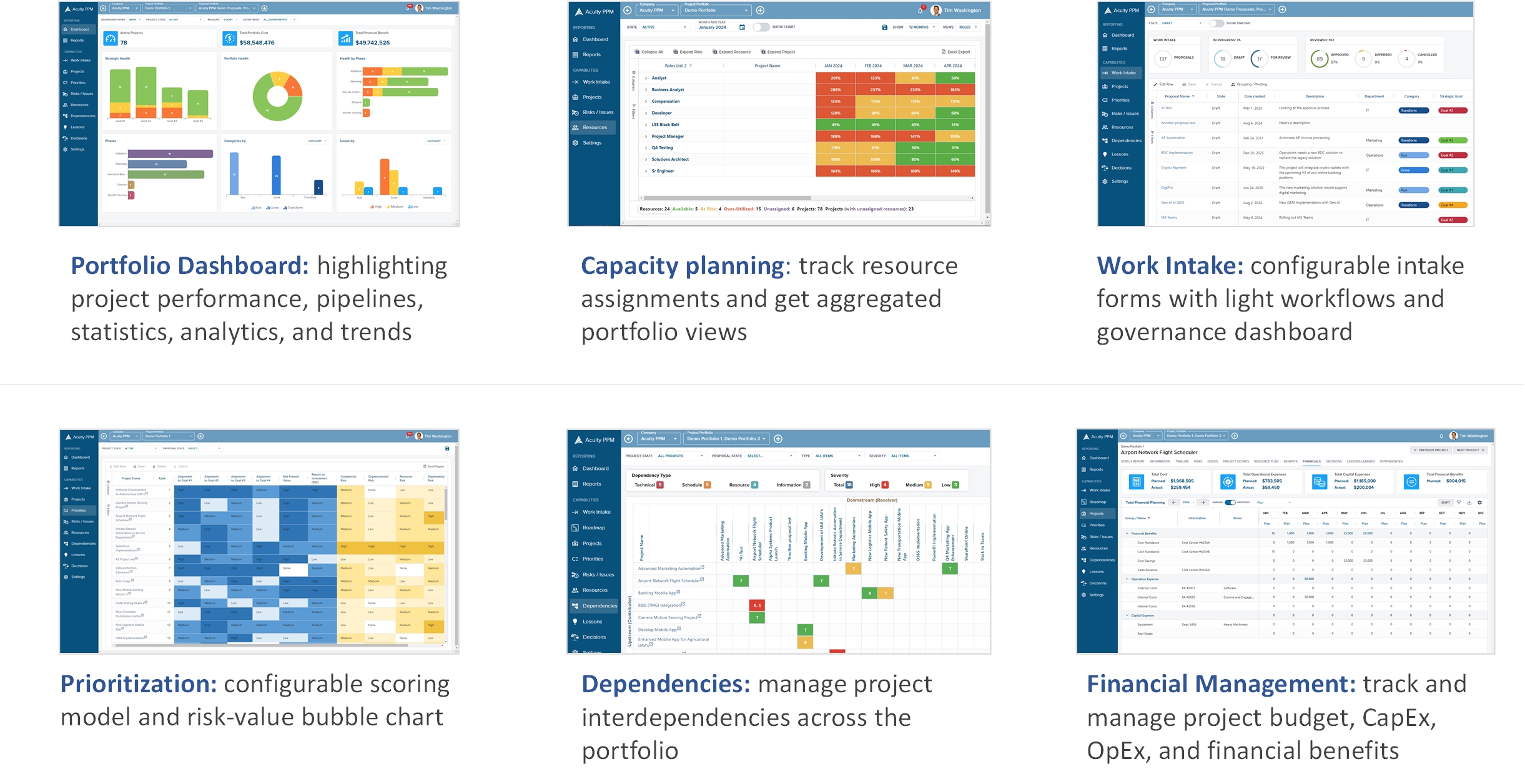
Tim is a undertaking and portfolio administration guide with over 15 years of expertise working with the Fortune 500. He’s an skilled in maturity-based PPM and helps PMO Leaders construct and enhance their PMO to unlock extra worth for his or her firm. He is likely one of the authentic PfMP’s (Portfolio Administration Professionals) and a public speaker at enterprise conferences and PMI occasions.
What undertaking administration capabilities does Asana provide?
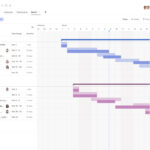
Asana affords a simple approach to centralize undertaking administration with sections, customized fields, and tags to categorize duties by precedence, standing, or crew, enhancing visibility and management over undertaking progress. Asana consists of many options corresponding to: centralized undertaking monitoring, job administration and dependency administration, automation and workflow templates, collaboration and communication, visibility and reporting, aim setting and alignment, and integration capabilities.
Is Asana a portfolio administration device?
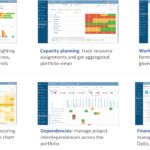
No, Asana for portfolio administration lacks a number of options that seasoned PMOs may anticipate for efficient portfolio administration. Asana lacks strong work consumption, prioritization scoring fashions, enterprise useful resource capability planning, portfolio-level threat administration, monetary monitoring, interdependency administration, and even fundamental PMO instruments corresponding to classes discovered and determination logs. Asana can simply be built-in with devoted portfolio administration instruments like Acuity PPM.



